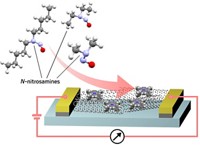Advertisement
Grab your lab coat. Let's get started
Welcome!
Welcome!
Create an account below to get 6 C&EN articles per month, receive newsletters and more - all free.
It seems this is your first time logging in online. Please enter the following information to continue.
As an ACS member you automatically get access to this site. All we need is few more details to create your reading experience.
Not you? Sign in with a different account.
Not you? Sign in with a different account.
ERROR 1
ERROR 1
ERROR 2
ERROR 2
ERROR 2
ERROR 2
ERROR 2
Password and Confirm password must match.
If you have an ACS member number, please enter it here so we can link this account to your membership. (optional)
ERROR 2
ACS values your privacy. By submitting your information, you are gaining access to C&EN and subscribing to our weekly newsletter. We use the information you provide to make your reading experience better, and we will never sell your data to third party members.
Analytical Chemistry
New Analytical Method Probes Harmful Organic Aerosols
Atmospheric Chemistry: Researchers demonstrate a fast, powerful mass spectrometry technique to monitor secondary organic aerosols
by Rajendrani Mukhopadhyay
June 25, 2010

Organic aerosols, a form of air pollution, can harm people's lungs, cause haze, and change climate. Now researchers have applied a new mass spectroscopy method to chemically analyze these airborne particles more rapidly than previous methods (Anal. Chem., DOI 10.1021/ac101028j).
Chemicals from pollution such as truck exhaust or from natural sources such as trees can react in the air to form particles called secondary organic aerosols. Because of the aerosols' detrimental effects to human health and local climate, scientists have studied them for decades. "It's really one of the hot areas in atmospheric chemistry today," says atmospheric chemist Barbara Finlayson-Pitts, of the University of California, Irvine.
Unfortunately, these studies have relied on time-consuming techniques and expensive equipment. And many of the more-rapid methods do not identify all the organic compounds in aerosol samples.
So Finlayson-Pitts and her colleagues looked for an alternative. They turned to atmospheric solids analysis probe mass spectrometry (ASAP-MS), a technique developed about five years ago to analyze drug and biological molecules. This technique requires little sample preparation, which is ideal for keeping the organic compounds intact without losing much sample or introducing artifacts. All the scientists needed to do was to allow the aerosols to adsorb onto a special disk and then use that disk to coat a small glass tube with the particles. Then they inserted this tube into a commercially available ASAP-MS adapter designed to inject the samples into most mass spectrometers.
The researchers studied particle samples that they had generated in their laboratory or had gathered in suburban or forested areas around their campus. From sample preparation to data collection, the ASAP-MS technique took minutes, the researchers report. Meanwhile, a similar analysis using previous methods might have taken hours.
Using ASAP-MS also allowed the scientists to detect molecules that existing techniques have missed. As they monitored a well-studied aerosol-forming reaction between nitrate radicals and α-pinene—a volatile molecule emitted by pine trees—in their laboratory, the scientists discovered high molecular weight oligomers. These products hadn't been detected in this reaction before, Finlayson-Pitts says.
Mass spectrometrist Murray Johnston, of the University of Delaware, who studies atmospheric aerosols, thinks that ASAP-MS could fill a hole in organic aerosol analysis. With existing mass spectrometry techniques, he says, scientists have a choice between only monitoring a few types of compounds rapidly and looking at a wide range of molecules with slower procedures. "The work by Finlayson-Pitts and colleagues," Johnston says, "bridges that gap."




Join the conversation
Contact the reporter
Submit a Letter to the Editor for publication
Engage with us on Twitter